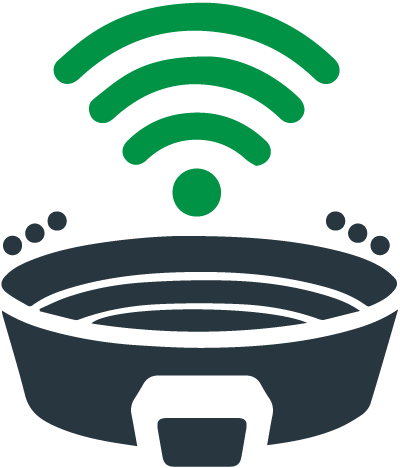New Connected Stadiums for Audience Participation Apps

Built at a cost of more than $1.2 billion, the recently-opened venue boasts a number of high-tech that would make any geek cheer. For starters, there are 680 free Wi-Fi access points distributed around the stadium (which is nearly one access point for every hundred fans) as well as 12,000 Ethernet ports, all supported by a supersonic 40-Gbps fiber optic connection that delivers broadband speeds 40 times faster than any other stadium.
According to TIME Magazine, this is all possible due to nearly 400 miles of cabling running throughout the structure. In addition, there are almost 1,200 Wi-Fi antennas located throughout the outdoor arena that boost the wireless signal every 100 seats or so. Another cutting-edge feature of the stadium is a collection of about 1,700 beacons, which can be used to know the whereabouts of spectators and provide them with useful, targeted information.
Much like the debut of the Botlr robot, the location of Levi’s Stadium deep within Silicon Valley likely helps enhance the building’s tech credentials. According to TIME, Sony has been a major contributor to the new connected stadium, contributing over 2,000 TVs, including 70 high-tech 4K units. Some of these flashier features will be obvious to fans, including the two giant scoreboards and 108-inch screen in one of the stadium’s restaurants. However, much of the technology will be hidden from view in a state-of-the-art computer network that would make many a tech startup jealous.
“This is truly a one-of-a-kind fan experience, with the world’s greatest showcase of 4K technology from the best of Sony’s professional and consumer products. For every event, every fan will be immersed in the pinnacle of entertainment and technology to enhance their experience,” Sony COO Mike Fasulo explains.
Befitting of a team deep in the heart of Silicon Valley, a true catalyst to changing the connected stadium experience for the average fan will be the stadium’s smartphone app. The app will allow fans to order food from their seat, which can either be delivered or picked up at an express area. It can provide a live telecast of the game along with up to four on-screen replays and live statistics. Most importantly, it can point you in the direction of the bathroom with the shortest line so that you don’t miss out on any of the action.
A new era of smart connected stadiums is just dawning, but as fans begin to utilize the new technology and connect during games, there will certainly be new trends and capabilities that develop. As the Internet of Things continues to emerge, it is without question that connected technologies will make the live sporting experience even more enjoyable. Game on!
This is a guest post from Atmel, and was originally published to the Atmel blog on August 26, 2014. Atmel Corporation is a worldwide leader in the design and manufacture of microcontrollers, capacitive touch solutions, advanced logic, mixed-signal, nonvolatile memory and radio frequency (RF) components.
The Rise of the Audience Participation Apps
In correlation with stadiums becoming smarter and more connected, interactive audience participation apps are being increasingly adopted for live, in-stadium events. Because stadiums have built out robust networks to connect their audience, developers have the opportunity to build applications to enable audience members to engage and interact with the game and one another.
Real-time technology has become the stimulus for interactive audience participation apps, enabling developers to deliver data in real time, whether it be chat messages, statistics, polls, or advertisements. Real-time data streams in a connected stadium is changing the way we view live events. And with the PubNub Data Stream Network, you can send and receive messages in under a 1/10 second, and add a plethora of other real-time features to your in-stadium application.
Get Started
Sign up for free and use PubNub to power
interactive audience participation
